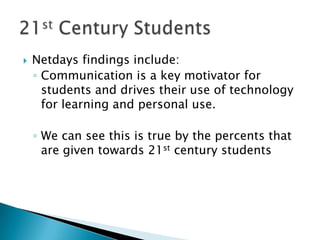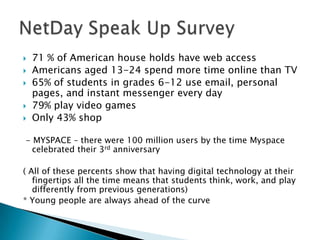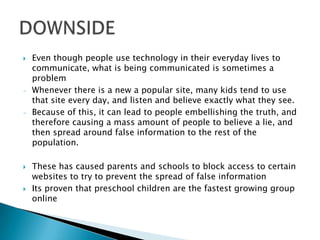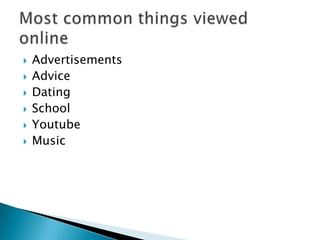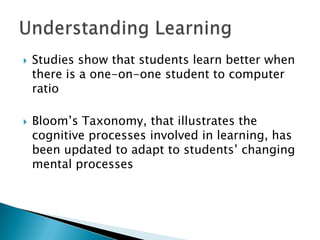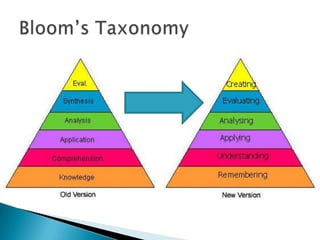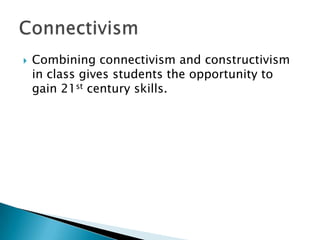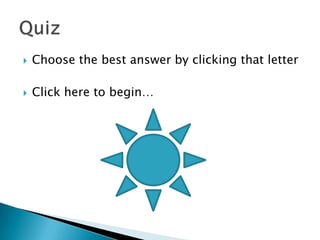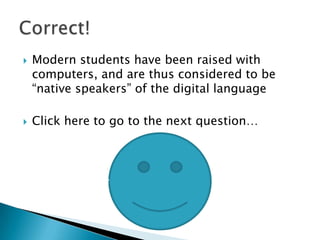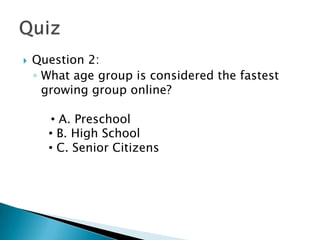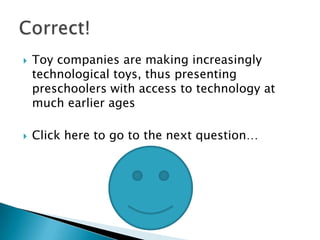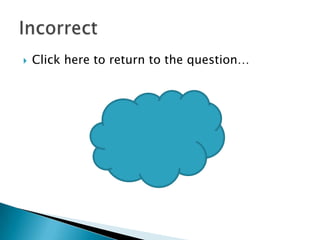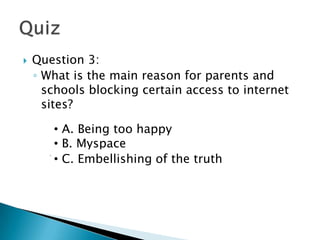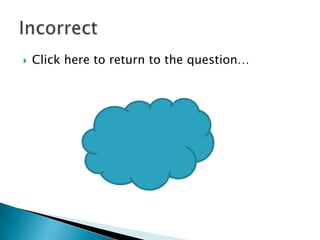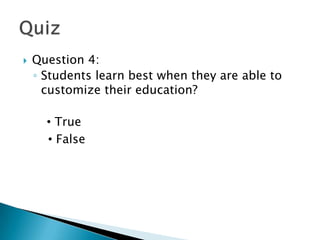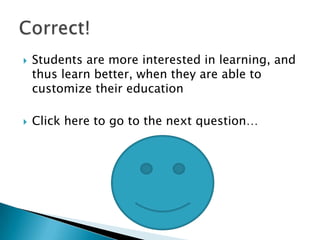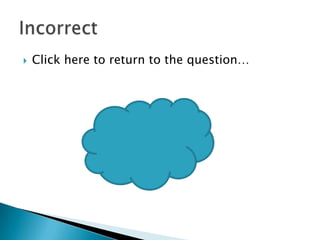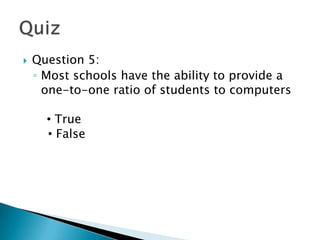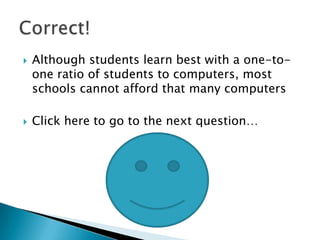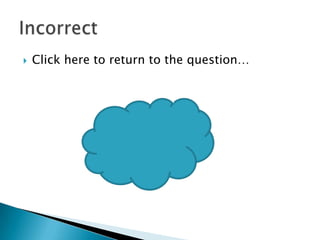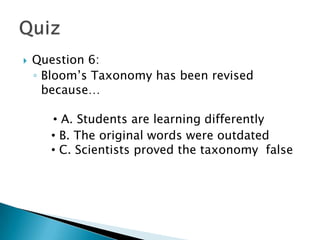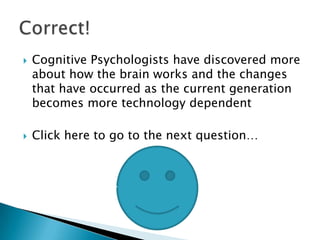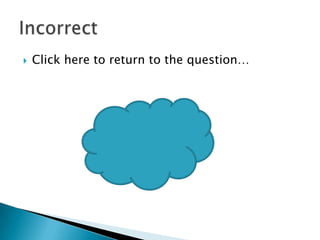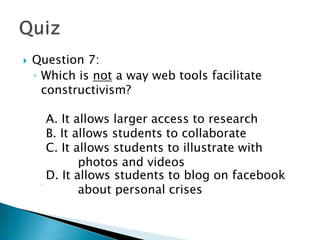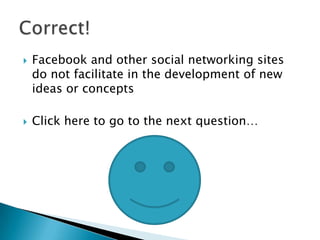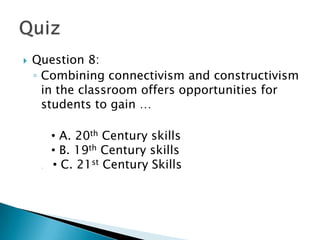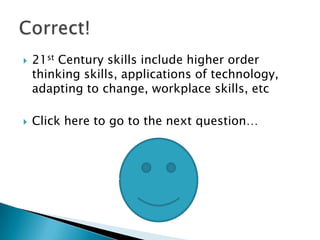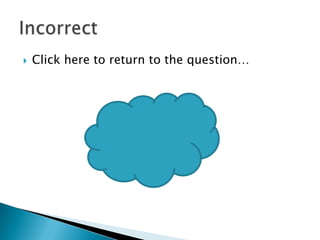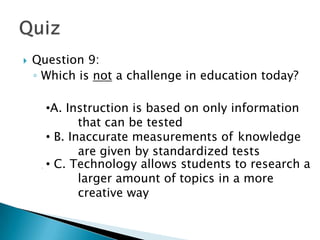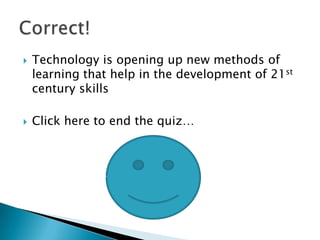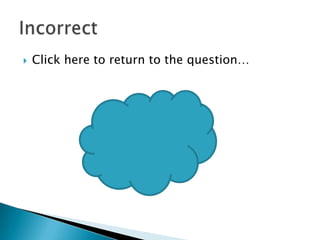Students and learning
- 1. Web 2.0: Chapter 2
- 2. ï― Todayâs students are likely to be a wired generation and todayâs teachers and parents are asking for help from younger kids and even their children ï― Technology affects how we live, communicate, when and where, and how we learn
- 3. ï― Netdays findings include: âĶ Communication is a key motivator for students and drives their use of technology for learning and personal use. âĶ We can see this is true by the percents that are given towards 21st century students
- 4. ï― 71 % of American house holds have web access ï― Americans aged 13-24 spend more time online than TV ï― 65% of students in grades 6-12 use email, personal pages, and instant messenger every day ï― 79% play video games ï― Only 43% shop - MYSPACE â there were 100 million users by the time Myspace celebrated their 3rd anniversary ( All of these percents show that having digital technology at their fingertips all the time means that students think, work, and play differently from previous generations) * Young people are always ahead of the curve
- 5. ï― Even though people use technology in their everyday lives to communicate, what is being communicated is sometimes a problem - Whenever there is a new a popular site, many kids tend to use that site every day, and listen and believe exactly what they see. - Because of this, it can lead to people embellishing the truth, and therefore causing a mass amount of people to believe a lie, and then spread around false information to the rest of the population. ï― These has caused parents and schools to block access to certain websites to try to prevent the spread of false information ï― Its proven that preschool children are the fastest growing group online
- 6. ï― Advertisements ï― Advice ï― Dating ï― School ï― Youtube ï― Music
- 7. ï― Students find the use of technology more enjoyable, and thus more educational, when they are able to customize the computers ï― In the classroom, allow students to choose their method of presentation, where they find their information, and what methods helps them learn the best
- 8. ï― Studies show that students learn better when there is a one-on-one student to computer ratio ï― Bloomâs Taxonomy, that illustrates the cognitive processes involved in learning, has been updated to adapt to studentsâ changing mental processes
- 10. ï― Web Tools help with constructivism because students have a larger access to research, collaborate information through wikis, and illustrate with photos and videos in order provide a more effective and creative product ï― Technology facilitates better project based activities because students can collaborate with adults and peers, manage work, engage in valuable activities, and work as a team
- 11. ï― Combining connectivism and constructivism in class gives students the opportunity to gain 21st century skills.
- 12. ï― Today, education goals are focused on testing rather than higher level thinking and more meaningful learning ï― Inaccurate measurements of intelligence are the product of standardized testing ï― Instruction is narrowed down to just test materials
- 13. ï― Choose the best answer by clicking that letter ï― Click here to beginâĶ
- 14. ï― Question 1: âĶ What does Marc Prensky consider students? ï A. Digital Immigrants âĒ A. Digital Immigrants âĒ B. Digital Genius ï B. Digital Genius âĒ C. Digital Natives ï C. Digital Natives
- 15. ï― Modern students have been raised with computers, and are thus considered to be ânative speakersâ of the digital language ï― Click here to go to the next questionâĶ
- 16. ï― Click here to return to the questionâĶ
- 17. ï― Question 2: âĶ What age group is considered the fastest growing group online? âĒ A. Preschool âĒ B. High School âĒ C. Senior Citizens
- 18. ï― Toy companies are making increasingly technological toys, thus presenting preschoolers with access to technology at much earlier ages ï― Click here to go to the next questionâĶ
- 19. ï― Click here to return to the questionâĶ
- 20. ï― Question 3: âĶ What is the main reason for parents and schools blocking certain access to internet sites? âĒ A. Being too happy ï A. Being too happy âĒ B. Myspace ï B. Myspace Embellishing of the âĒC. âĒ C. Embellishing of the truth truth
- 21. ï― Schools and parents are increasingly worried about students accessing and passing false information about themselves ï― Click here to go to the next questionâĶ
- 22. ï― Click here to return to the questionâĶ
- 23. ï― Question 4: âĶ Students learn best when they are able to customize their education? ï âĒTrue True False ï âĒ False
- 24. ï― Students are more interested in learning, and thus learn better, when they are able to customize their education ï― Click here to go to the next questionâĶ
- 25. ï― Click here to return to the questionâĶ
- 26. ï― Question 5: âĶ Most schools have the ability to provide a one-to-one ratio of students to computers True ï âĒTrue ï âĒ False False
- 27. ï― Although students learn best with a one-to- one ratio of students to computers, most schools cannot afford that many computers ï― Click here to go to the next questionâĶ
- 28. ï― Click here to return to the questionâĶ
- 29. ï― Question 6: âĶ Bloomâs Taxonomy has been revised becauseâĶ âĒ A. Students are learning differently âĒ B. The original words were outdated âĒ C. Scientists proved the taxonomy false B. The original words were outdated C. Scientists proved the taxonomy false
- 30. ï― Cognitive Psychologists have discovered more about how the brain works and the changes that have occurred as the current generation becomes more technology dependent ï― Click here to go to the next questionâĶ
- 31. ï― Click here to return to the questionâĶ
- 32. ï― Question 7: âĶ Which is not a way web tools facilitate constructivism? ïA. It allows larger access to research A. It allows larger access to research ïB. It allows students to collaborate B. It allows students to collaborate C. It allows students to illustrate with ï C. It allows students to illustrate with photos and videos photos and videos D. It allows students to blog on facebook ï D. It allows personal crises on facebook about students to blog about personal crises
- 33. ï― Facebook and other social networking sites do not facilitate in the development of new ideas or concepts ï― Click here to go to the next questionâĶ
- 34. ï― Click here to return to the questionâĶ
- 35. ï― Question 8: âĶ Combining connectivism and constructivism in the classroom offers opportunities for students to gain âĶ ï A.A. 20th Century skills âĒ 20th Century skills ï B.B. 19th Century skills âĒ 19th Century skills ï âĒ C. 21st Century Skills C. 21s
- 36. ï― 21st Century skills include higher order thinking skills, applications of technology, adapting to change, workplace skills, etc ï― Click here to go to the next questionâĶ
- 37. ï― Click here to return to the questionâĶ
- 38. ï― Question 9: âĶ Which is not a challenge in education today? ïâĒA. Instruction is based on only information A. that can be tested that can be tested B. Inaccurate measurements of knowledge ïâĒB. Inaccurate measurements of knowledge are given by standardized tests tests are given by standardized ïâĒC. Technology allows students to research a C. Technology allows students to research larger amount of topics in a more a larger amount of topics in a more creative way way creative
- 39. ï― Technology is opening up new methods of learning that help in the development of 21st century skills ï― Click here to end the quizâĶ
- 40. ï― Click here to return to the questionâĶ



